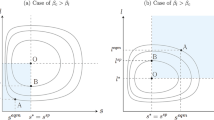Abstract
This paper explores the consequences fordiscounting of assuming limits to growth. One of the main determinants of the discount rate is the rate of economic growth. If growth rates decline in the future then the discount rate should not be constant but also decline over time. In fact, we would then need not a single discount rate but rather a variable discount schedule. This would imply higher present values for the distant future. The paper analyses how discount rates would vary with different assumptions about the patterns of growth and the pure rate of time preference.
Similar content being viewed by others
References
Arrow, K. J. and R. C. Lind (1970), ‘Uncertainty and the Evaluation of Public Investment Decisions’,American Economic Review 60, 364–378.
Ayres, R. and J. Walter (1992), ‘The Greenhouse Effect: Damages, Costs and Abatement’,Environmental and Resource Economics 1(3), 237–270.
Baumol, W. J. (1968), ‘On the Social Rate of Discount’,American Economic Review 58, 788–802.
Dasgupta, P. S. and G. M. Heal (1979),Economic Theory and Exhaustible Resources, CUP, Cambridge.
Hanley, N. (1992), ‘Are There Environmental Limits to Cost-Benefit Analysis?’,Environmental and Resource Economics 2(1).
Kula, E. (1988), ‘Future Generations: The Modified Discounting Approach’,Project Appraisal 3, 85–88.
Lind, R. C., K. J. Arrow, G. R. Corey, P. Dasgupta, A. K. Sen, T. Stauffer, J. E. Stiglitz, J. A. Stockfisch, and R. Wilson (1982),Discounting for time and risk in Energy Policy, Resources for the Future, Washington.
Marglin, S. (1963), ‘The Social Rate of Discount and the Optimal Rate of Investment’,Quarterly Journal of Economics 77, 95–111.
Nordhaus, W. (1991), ‘To Slow or not to Slow: The Economics of the Greenhouse Effect’,The Economic Journal 101(407).
Norgaard, R. and R. Howarth (1991), ‘Sustainability and Discounting the Future’, in R. Constanza, ed.,Ecological Economics, Columbia UP, New York.
Pigou, A. C. (1932),The Economics of Welfare (4th ed), Macmillan & Co. London.
Price, C. (1991), ‘Do High Discount Rates Destroy Tropical forests?’,Journal of Agricultural Economics 42(1), 77–85.
Ramsey, F. (1928), ‘A Mathematical Theory of Saving’,Economic Journal 38.
Young, M. D. (1992), ‘Sustainable Investment and Resource Use’,Man and the Biosphere Series 9, UNESCO Press.
Author information
Authors and Affiliations
Additional information
An earlier version of this paper was presented at the conference “ECOLOGICAL ECONOMICS”, Stockholm, August 1992. I am grateful for valuable comments from Partha Dasgupta, Gunnar Köhlin, Karl-Göran Mäler, Mike Young and two anonymous referees.
Rights and permissions
About this article
Cite this article
Sterner, T. Discounting in a world of limited growth. Environ Resource Econ 4, 527–534 (1994). https://doi.org/10.1007/BF00691927
Issue Date:
DOI: https://doi.org/10.1007/BF00691927




